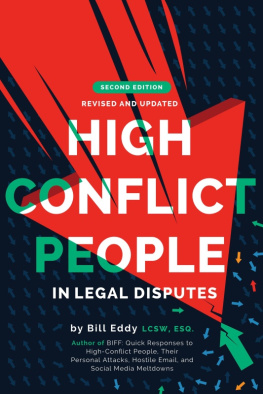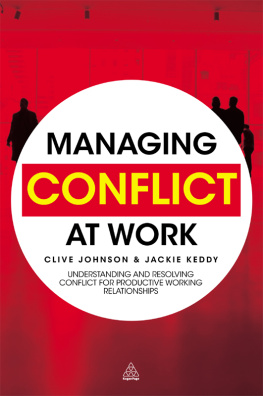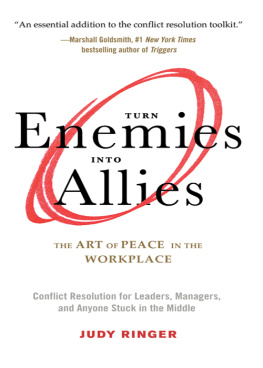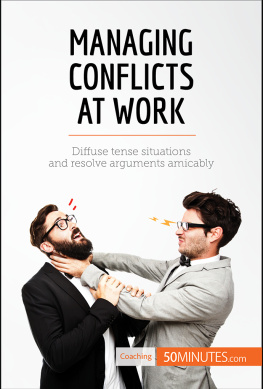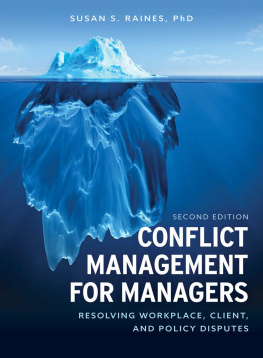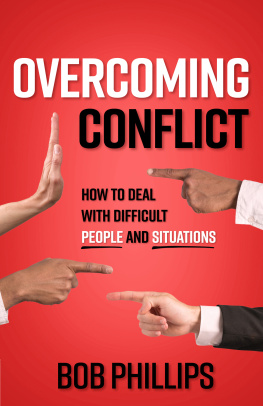Conflict First Aid
Conflict First Aid
How to Stop Personality Clashes
and Disputes from Damaging You
or Your Organization
Nancy Radford

Conflict First Aid: How to Stop Personality Clashes and Disputes from Damaging You or Your Organization
Copyright Business Expert Press, LLC, 2018.
All rights reserved. No part of this publication may be reproduced, stored in a retrieval system, or transmitted in any form or by any meanselectronic, mechanical, photocopy, recording, or any other except for brief quotations, not to exceed 250 words, without the prior permission of the publisher.
First published in 2018 by
Business Expert Press, LLC
222 East 46th Street, New York, NY 10017
www.businessexpertpress.com
ISBN-13: 978-1-63157-973-8 (paperback)
ISBN-13: 978-1-63157-974-5 (e-book)
Business Expert Press Human Resource Management and Organizational Behavior Collection
Collection ISSN: 1946-5637 (print)
Collection ISSN: 1946-5645 (electronic)
Cover and interior design by S4Carlisle Publishing Services Private Ltd., Chennai, India
First edition: 2018
10 9 8 7 6 5 4 3 2 1
Printed in the United States of America.
Abstract
This book gives practical tips on how to manage disputes and personality clashes before they create major problems for business and relationships. Written in laymens terms with examples, acronyms, and illustrations, it helps the reader understand the causes of conflict and how it develops and escalates. The author explains the scientific basis for seemingly illogical behavior under stress and in conflict and also offers tips and tools for managing emotions and behaviors in difficult situations.
Guidance is provided on setting and maintaining standards, balancing responsibilities with relationships, and dealing with negative issues before serious damage is done. The book is structured so that it can either be read as a whole or the relevant section accessed in a crisis, with a toolkit of resources at the end. Each chapter ends with questions to check understanding. Full of convenient tools and insights into managing emotions and handling disagreements, it provides a handy resource for managers and employees.
Keywords
boundaries, conflict management, conflict resolution, confrontations, disagreements, discipline, dispute resolution, personality clashes
All photographs and figures in this article are my own work. Quotations are referenced.
Contents
I owe a huge debt of gratitude to the many people who have made this book possible. Thank you so much to
Business Expert Press and S4Carlisle for making things so easy, especially Nigel, Charlene, Rob, and Kiruthigadevi
Mentors, leading lights and coaches for guidance; especially Anthony Glaister, Aldo Civico, and the many researchers and authors quoted in this book
Family, friends, and clients for their unswerving faith in me; especially Frances, Sandy, Clare, Martha, Tim, Rob, Pele, Peter, Ute, Diamond Mastermind Group, the Sauers, Morgans, and all those that trusted me to work with them at critical and difficult times in their lives.
Jody Chrastek, Ann Seibert, and Alisdair Butler for time reviewing and giving great feedback and encouragement.
My husband, Giles, for his unstinting encouragement, cheerfulness, and steadfast practical support.
Pain and conflict have a lot in commonwe try and avoid them both. When they occur, we try and get rid of them as soon as possible and we do not like talking about them. Yet, this is not healthy.
We would all like to avoid pain, yet one of the most dreaded diseases of the past was leprosy, where people lost the ability to feel pain. So, they did not pull away from a burning object, did not feel a rat gnawing at their feet, and ignored sores. This led to injuries festering, loss of limbs, disfigurements, and eventually, death.
When we fear conflict or do not know how to handle it, the cost of avoidance can be high. Avoiding conflict results in festering resentments or eventual explosions. Respect and love fade. Or, we pretend there is no conflict, and instead of talking about it, we act it outwe become sarcastic, uncooperative, or devious. The most common way to avoid conflict is to talk about people, instead of to them. Little issues become big ones. Minor grievances chafe and resentment eats away at contentment. We tell ourselves stories where we are the hero, and the other, the unwitting villain. Our flight or fight response switches on without being able to discharge and stress levels rocket. Research links more and more ailments to this constant state of stimulation.
No matter how civilized a society you live in or how calm and zen-like you become, conflict and pain are a part of life. Yet, if we know the causes, understand our responses, and learn appropriate strategies, we can minimize the negative impact of them both.
This book grew out of my vision to create a practical resource that would help people manage conflict positively, wherever possible. This is not a manual for those who want to go into the field professionally, nor can it take the place of training and experience. It is intended to introduce this critical and interesting facet of leadership as well as provide some guidance in difficult situations. helps you decide whether to wade in or walk on when others are in conflict, and provides some guidelines on when to call external assistance.
Although you may want to go straight to the practical chapters, reading the first two chapters will help you realize why you and others react in unhelpful ways. This knowledge will enhance your understanding of the practical tools and make it easier to adapt them to your particular situation. gathers all the tools scattered throughout this book into one place for ease of use in future, with an overview of recommended resources.
I hope this book opens the door to conflict management and encourages you to explore this fascinating and extremely important topic.
Causes, costs, escalation, and theories
What Causes Conflict?
People have different cultures, values, interests, personalities, status, and access to resources. Of course, differencesof themselvesare not necessarily a cause of conflict. They become a source of conflict when people believe they are not respected, valued, or understood.
Christopher Moore (Moore 2003) presents a model which categorizes differences that often result in conflicts. The following table sets them out.
Moores model is useful for identifying and analyzing multiple causes of conflict, for example, when different cultures or religions clash, such as between Muslims and Christians. This is often intensified by a lack of information, misinformation, or different interpretations of the data and its relevance. Relationships suffer due to miscommunication, negative behavior, and stereotyping. The resulting competition for power or a voice can cause conflicts of interest and result in destructive behavior patterns, unequal power, and authority. A small difference suddenly becomes a cause for war.
The causes Moore sets out are often more obvious in larger or more formal conflicts, such as international conflicts or civil legal cases. It may be harder to define the cause in domestic or workplace conflict using his criteria. Scott provides another, more practical, description of the reasons people disagree (Scott 2008):



